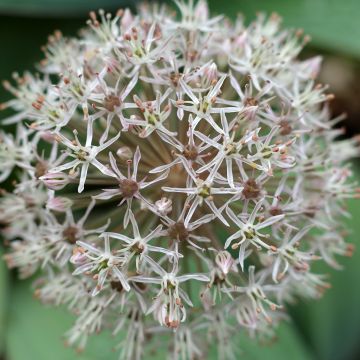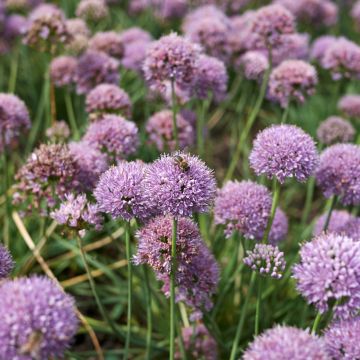

Ail d'ornement - Allium senescens Lisa Blue
Allium senescens Lisa Blue
Allium x senescens Lisa Blue
German garlic, Mountain garlic, Pink lily leek, Ornamental Onion
This item cannot be shipped to the selected country
Delivery charge from €5.90
Delivery charge from €5.90
More information
Schedule delivery date,
and select date in basket
This plant carries a 6 months recovery warranty
More information
We guarantee the quality of our plants for a full growing cycle, and will replace at our expense any plant that fails to recover under normal climatic and planting conditions.
From €5.90 for pickup delivery and €6.90 for home delivery
Express home delivery from €8.90.
From €5.90 for pickup delivery and €6.90 for home delivery
Express home delivery from €8.90.
Does this plant fit my garden?
Set up your Plantfit profile →
Description
Allium senescens 'Lisa Blue' is a variety of A. senescens 'Lisa Green' but with bluish-green foliage. These two ornamental garlic cultivars have the advantage of bearing beautiful foliage from spring to autumn, even after flowering. This garlic produces a clump of ribbon-like, linear foliage with a bluish tint, which nicely complements its round heads of tender pink flowers tinged with blue. The flowering takes place generously in August and September, much to the delight of pollinating insects. It thrives in the sun, in well-draining soil. Hardy and tolerant of summer drought, it beautifully enhances rock gardens, sunny borders, and pots. Its flowers are long-lasting in fresh or dried bouquets.
Allium senescens 'Lisa Blue' is a hybrid variety of ornamental garlic derived from the species A. senescens. This cultivar develops in spring from a bulbous rhizome that forms a beautiful clump of upright, fairly thin, glossy, bluish-green leaves. It reaches about 30cm (12in) in height and spreads laterally through its slightly suckering rhizome, at least 30cm (12in). The flowering takes place in August and September, in average climates. Flowering stems measuring 30cm (12in) in height emerge from the centre of the tufts. Each stem bears a solitary inflorescence in the shape of a sphere 5 to 6cm (2in) in diameter. The inflorescences are composed of a multitude of tiny lilac-pink star-shaped flowers. They are nectar-rich and attractive to bees.
Planted en masse along a pathway, as a border for flower beds, or even combined with perennials in shades of pink and blue, this perennial 'Lisa Blue' garlic proves remarkable in a romantic mixed-border. It pairs well with daylilies, bellflowers, and agastaches. In an unusual bed mixing flowers and vegetables, it can be accompanied by chives, over-ripe chard with colourful stalks, bulbous fountain grass, purple basil, and many more. For a more dynamic effect, its flowers can structure a contemporary garden where various geometric shapes oppose each other. It can be paired with fine-leafed feather grass, lavender, and cone-shaped trimmed boxwoods.
In short, the possibilities are endless! There is certainly a corner of your garden where this garlic will work wonders.
Report an error about the product description
Allium senescens Lisa Blue in pictures


Plant habit
Flowering
Foliage
Botanical data
Allium
x senescens
Lisa Blue
Alliaceae - Liliaceae
German garlic, Mountain garlic, Pink lily leek, Ornamental Onion
Cultivar or hybrid
Other Allium
Planting and care
Allium senescens 'Lisa Blue' should be planted in autumn at a depth of 8 to 10cm (3 to 4in) in moist but well-drained, rocky, or sandy soil in a warm location, spaced 15cm (6in) apart. In warm climates, shade is well tolerated during the hottest hours of the day. Add sand to the planting hole to improve bulb drainage. Avoid heavy soils. It can withstand harsh winters if it is not subjected to stagnant water. It can also be grown in a pot, using a light substrate composed of 1/3 sand, 1/3 potting soil, and 1/3 perlite.
Planting period
Intended location
Care
-
, onOrder confirmed
Reply from on Promesse de fleurs
Haven't found what you were looking for?
Hardiness is the lowest winter temperature a plant can endure without suffering serious damage or even dying. However, hardiness is affected by location (a sheltered area, such as a patio), protection (winter cover) and soil type (hardiness is improved by well-drained soil).

Photo Sharing Terms & Conditions
In order to encourage gardeners to interact and share their experiences, Promesse de fleurs offers various media enabling content to be uploaded onto its Site - in particular via the ‘Photo sharing’ module.
The User agrees to refrain from:
- Posting any content that is illegal, prejudicial, insulting, racist, inciteful to hatred, revisionist, contrary to public decency, that infringes on privacy or on the privacy rights of third parties, in particular the publicity rights of persons and goods, intellectual property rights, or the right to privacy.
- Submitting content on behalf of a third party;
- Impersonate the identity of a third party and/or publish any personal information about a third party;
In general, the User undertakes to refrain from any unethical behaviour.
All Content (in particular text, comments, files, images, photos, videos, creative works, etc.), which may be subject to property or intellectual property rights, image or other private rights, shall remain the property of the User, subject to the limited rights granted by the terms of the licence granted by Promesse de fleurs as stated below. Users are at liberty to publish or not to publish such Content on the Site, notably via the ‘Photo Sharing’ facility, and accept that this Content shall be made public and freely accessible, notably on the Internet.
Users further acknowledge, undertake to have ,and guarantee that they hold all necessary rights and permissions to publish such material on the Site, in particular with regard to the legislation in force pertaining to any privacy, property, intellectual property, image, or contractual rights, or rights of any other nature. By publishing such Content on the Site, Users acknowledge accepting full liability as publishers of the Content within the meaning of the law, and grant Promesse de fleurs, free of charge, an inclusive, worldwide licence for the said Content for the entire duration of its publication, including all reproduction, representation, up/downloading, displaying, performing, transmission, and storage rights.
Users also grant permission for their name to be linked to the Content and accept that this link may not always be made available.
By engaging in posting material, Users consent to their Content becoming automatically accessible on the Internet, in particular on other sites and/or blogs and/or web pages of the Promesse de fleurs site, including in particular social pages and the Promesse de fleurs catalogue.
Users may secure the removal of entrusted content free of charge by issuing a simple request via our contact form.
The flowering period indicated on our website applies to countries and regions located in USDA zone 8 (France, the United Kingdom, Ireland, the Netherlands, etc.)
It will vary according to where you live:
- In zones 9 to 10 (Italy, Spain, Greece, etc.), flowering will occur about 2 to 4 weeks earlier.
- In zones 6 to 7 (Germany, Poland, Slovenia, and lower mountainous regions), flowering will be delayed by 2 to 3 weeks.
- In zone 5 (Central Europe, Scandinavia), blooming will be delayed by 3 to 5 weeks.
In temperate climates, pruning of spring-flowering shrubs (forsythia, spireas, etc.) should be done just after flowering.
Pruning of summer-flowering shrubs (Indian Lilac, Perovskia, etc.) can be done in winter or spring.
In cold regions as well as with frost-sensitive plants, avoid pruning too early when severe frosts may still occur.
The planting period indicated on our website applies to countries and regions located in USDA zone 8 (France, United Kingdom, Ireland, Netherlands).
It will vary according to where you live:
- In Mediterranean zones (Marseille, Madrid, Milan, etc.), autumn and winter are the best planting periods.
- In continental zones (Strasbourg, Munich, Vienna, etc.), delay planting by 2 to 3 weeks in spring and bring it forward by 2 to 4 weeks in autumn.
- In mountainous regions (the Alps, Pyrenees, Carpathians, etc.), it is best to plant in late spring (May-June) or late summer (August-September).
The harvesting period indicated on our website applies to countries and regions in USDA zone 8 (France, England, Ireland, the Netherlands).
In colder areas (Scandinavia, Poland, Austria...) fruit and vegetable harvests are likely to be delayed by 3-4 weeks.
In warmer areas (Italy, Spain, Greece, etc.), harvesting will probably take place earlier, depending on weather conditions.
The sowing periods indicated on our website apply to countries and regions within USDA Zone 8 (France, UK, Ireland, Netherlands).
In colder areas (Scandinavia, Poland, Austria...), delay any outdoor sowing by 3-4 weeks, or sow under glass.
In warmer climes (Italy, Spain, Greece, etc.), bring outdoor sowing forward by a few weeks.













































